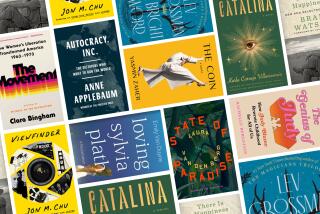The Pushcart Prize, X : BEST OF THE SMALL PRESSES, 1985-86, edited by Bill Henderson (Pushcart: $25; 499 pp.) : TQ: TWENTY YEARS OF THE BEST CONTEMPORARY WRITING AND GRAPHICS FROM TRIQUARTERLY, edited by Reginald Gibbons and Susan Hahn (Pushcart: $28; 667 pp.)
- Share via
The conventional wisdom is correct. Since the end of the Korean War, fewer and fewer large circulation magazines have published fiction (and even fewer serious poetry), but at the same time, the writing population of the United States seems to have increased--and certainly brushed up on its technique--probably as the result of the growing number of writing programs, most at the graduate level, some undergraduate, and proliferating summer workshops around the country.
Where to publish, then? The 15-page list at the end of the annual Pushcart Prize volume offers hundreds of answers, from “Agada,” a journal published in Berkeley, to “Yellow Silk” published in the neighboring Albany, with magazines and journals in between such as “Black Warrior Review,” “The Long Story,” “MSS.,” “New Letters,” “Tar River Poetry” and “The Walt Whitman Review,” out of Tuscaloosa, North Andover, Mass., Binghampton, N.Y., Columbia, Mo., Chapel Hill and Iowa City, respectively.
The annual Pushcart Anthology of the best from the little magazine will probably be here to help the interested reader to sample across this vast smorgasbord of new American writing, not all of it satisfying, but all of it fresh. For the person who enjoys good, sometimes innovative fiction, this year’s volume will be attractive, what with stories by Stuart Dybek (who recently won one of the new $25,000 Whiting Awards and so is better known now, and deservedly so, than when he first published the piece included here, “Hot Ice,” an elegiac tale about Chicago working class life, in “Antaeus,” Tim O’Brien (with a piece from his daring new novel “The Nuclear Age”) T. C. Boyle and William Kittredge, two marvelous short- story makers from west of the Continental Divide; Russell Banks, with a New Hampshire story that fiddles with form but in the end drives to the heart, and Janet Kauffman, who teaches and works a farm in Michigan, with a Detroit story that deserves to go national.
These alone would have made a fine little anthology. Add to them some interesting essays, Adam Gussow’s “Bohemia Revisited: Malcolm Cowley, Jack Kerouac,” and “On the Road,” a fascinating study of the role of contemporary editors and writers in their struggle to publish what each believes to be the best work possible; and Doris Lessing’s remarks about her recent pseudonymous publications, and some fine verse from known and unknown poets alike, including a new, long piece by Philip Levine, “A Poem With No Ending,” from “The Paris Review,” that held me as only a good story can, and you’ve got quite a lineup, and not all of them the usual suspects when it comes to alerting ourselves to the current possibilities of contemporary writing.
The Pushcart Prize Annual celebrates one year at a time. “TriQuarterly 20,” the latest retrospective anthology in Bill Henderson’s series of collections from the volumes of our best literary magazines, honors two decades’ and three editors’ worth of excellent judgment. The lineup of writers here, an international crew, is world-class, and the book argues quite credibly that “TriQuarterly” is our single best literary journal of the last 20 years. For breadth of inclusion--here are Latin Americans and Eastern Europeans, black writers, white writers, Jewish women, Catholic men, native Americans, Greek poets, Russians--the anthology stands tall. It deserves the best marks for taste as well, not only for publishing such well-known writers as Robert Stone, Cynthia Ozick, J. L. Borges, Carlos Fuentes, John Ashbery, W. S. Merwin, Al Young, Dave Smith, but for bringing to light as well some at the time lesser known but marvelous writers such as Raymond Carver, Pamela Hadas, Tobias Wolff, R. D. Skillings, David Quammen, Richard Ford and Amy Hempel; and for bringing back into print with some fanfare work by the late great Texas novelist and story-writer William Goyen.
“TriQuarterly” at its best--and its best certainly comes together in these hardcovers--is an integral part of a literate person’s library, the magazine to look for when seeking first-rate new fiction, poetry and essays. Its design amuses, too, and makes this particular volume the gift of gifts for young would-be writers who were pushing crayons across blank paper when some of the stories here first appeared. If some valuable big fish and little seem to have escaped the “TriQuarterly” net--such as, for example, the great Peruvian novelist Mario Vargas Llosa or the late John Gardner, whose old chums William Gass and Stanley Elkin are represented here, or younger writers such as, say, novelist Allen Wier, story writer Barry Lopez, poets Robert Pinsky and Gjertrud Schnackenberg (either because they weren’t solicited for material or didn’t submit, or didn’t submit what the editors took to be their best work) that means only that the editors haven’t been infallible. Just nearly infallible. Maybe some of these writers did get included in the actual magazine itself but not in the anthology, and I missed the issues in which they appeared. I’ll try not to miss any more issues ever.
More to Read
Sign up for our Book Club newsletter
Get the latest news, events and more from the Los Angeles Times Book Club, and help us get L.A. reading and talking.
You may occasionally receive promotional content from the Los Angeles Times.






